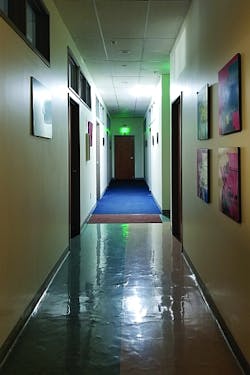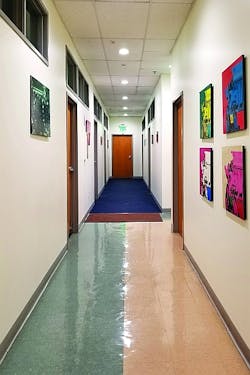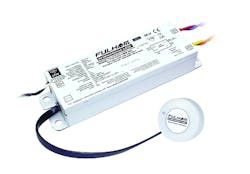Everyone has been talking about smart buildings and building automation, but the challenge always has been how to deploy building intelligence. What’s the best way to connect building systems into a central infrastructure? Perhaps the most logical place to start is by augmenting building safety using connected emergency lighting systems and then expanding the system to support building automation.
Emergency luminaires are required in all commercial structures, and they have to be strategically placed to cover the entire building (Fig. 1). Emergency lights are already linked to building alarm systems so those “bug-eye” lights can show the way to the nearest exit in the event of an emergency or power outage. Now what if you were to use those same emergency luminaires to create a wireless network capable of automating building safety systems? That same infrastructure can then be readily extended to manage a wide range of building systems.
Before we review the possibilities of a connected, intelligent building infrastructure, let’s consider the rationale for creating a smart emergency lighting infrastructure.
Extensible emergency lighting infrastructure
Emergency lighting systems are an ongoing concern for building maintenance and facilities management teams. Safety regulations require that staff walk the building regularly to test and log each emergency luminaire, including testing functionality and the batteries. LED luminaires are more efficient and simplify emergency lighting testing, including indicators that display red or green solid or flashing LEDs to show system readiness, as required by standards such as CSA C22.2 NO. 141 in North America and BS EN 50172:2004 / BS 5266-8:2004 in Europe. However, building maintenance staff still need to conduct a visual inspection, which is always time-consuming.
If you connect those LED emergency luminaires into a single system, you can create a means for centralized monitoring and management. Once they are connected, you can inspect emergency luminaires from any location, including performing diagnostics to detect unit failures. You can even issue instructions to execute and log luminaire tests on a regular basis, including annual tests that require lights be operated for the full duration required, usually 90 minutes or more until the battery is drained. Once testing is complete, the results are automatically logged and lights returned to a readiness state, all without requiring a physical inspection.
FIG. 1. Emergency lighting is required to kick in for a minimum of 90 minutes when alarm conditions are detected. The ambient LED luminaires are operational when conditions are normal (top), whereas emergency luminaires provide illumination for egress points under emergency conditions (bottom).
While automating testing for regulatory compliance may not be sufficient incentive to retrofit emergency luminaires, consider the added value of using that same infrastructure for other types of data- and sensor-related services. Once you have the network in place, you can use it to handle BACnet data or even support data traffic for Internet of Things (IoT) management. Integrating smart emergency luminaires with building automation systems (BAS) can enable a new level of building controls to make facilities safer and easier to manage.
Intelligent emergency LEDs: Step 1
The place to start is by installing intelligent emergency lighting components. Emergency LED luminaires are manufactured using semiconductors, which means the LED’s microcontroller-based driver enables the engine to be programmable (Fig. 2). Normally you would program LEDs to adjust their lighting characteristics, such as matching luminaire brightness, changing hue, metering energy consumption, making them dimmer or brighter, etc. For example, when retrofitting LED luminaires, it’s common to have to adjust brightness and hue to ensure the new units match older, existing luminaires. However, there is no reason you can’t program these same luminaires for other functions as well.
FIG. 2. Specialty LED drivers and control modules can be designed to provide additional programmability to connected emergency lighting and building systems for features such as remote maintenance and monitoring, dimming, power metering, data collection, commissioning, and more.
We have already talked about regulatory requirements to automate regular emergency luminaire testing. To be truly valuable, automated testing has to go beyond simple validation and diagnostics. Ideally, emergency luminaires should be programmable to support more comprehensive capabilities, including:
- The ability to test systems from anywhere, anytime, including functional test, duration test, automatic logging, and automated failure alerts.
- Support for real-time emergency monitoring, including both current status and incident alerts.
- Remote maintenance and monitoring with alerts for conditions such as unit failures and end-of-life for components such as drivers, lamps, and batteries.
- Full integration with other security and emergency access systems.
- Inclusion of programmable features such as intelligent evacuation response and occupant detection.
- Data gathering for analytics to assess factors such as building occupancy trends and traffic patterns.
- The ability to handle simple remote commissioning as well as issuing firmware updates.
The goal is to not only make emergency lighting systems easier to manage but to make buildings safer. For example, sensors in emergency luminaires can not only be used to trigger an alarm but to provide the location of the hazard as well. Using machine intelligence, the system could then activate specific lights to direct building occupants away from the hazard and toward the nearest safe exit.
Of course, to make this sort of smart building alert system work, you need to connect emergency luminaires together. You need communications as well as programmable intelligence.
Communications consolidates control
To connect emergency luminaires into a single ecosystem you have two basic connectivity options: wired and wireless.
Wiring together a network of luminaires certainly is an option for new construction. Newer buildings are being designed with system intelligence in mind so wiring together luminaires can be part of the design, especially if you start powering lighting using Power over Ethernet (PoE). With PoE, you can use the same wiring for data and power.
However, the market for LED retrofits promises to outpace new construction for some time to come, especially when you consider that only 8% of commercial building capacity is built as new each year, and more than half of all commercial buildings still in use are more than 60 years old. Since physically wiring together a lighting infrastructure is impractical, wireless communications are proving to be a much more viable option.
With more building owners contracting for LED retrofits to save energy, retrofitting with smart LED luminaires that feature on-board wireless communications is a logical approach. Adding wireless means you don’t have to rip and replace to create a building management infrastructure, but the next question is which wireless standard to use.
There is nothing new about wireless lighting communications. ZigBee (IEEE 802.15.4), for example, is a low-power radio platform that has been around since 1998. The problem with ZigBee is that it works only at close range and it can’t handle other types of data traffic, so it is limited to lighting controls. To connect devices beyond emergency lighting systems, you need to use an extensible, open standard.
Bluetooth Mesh is rapidly gaining market momentum as a preferred approach to create a wireless lighting ecosystem. Bluetooth has been around for decades and is a mature, open standard for device-to-device communications. Bluetooth Mesh is somewhat newer but is based on the same open standard, so it’s easier for manufacturers to develop products that are assured to be compatible.
Another distinct advantage to Bluetooth Mesh is it supports two-way communications, so the ecosystem can handle commissioning and software updates as well as monitoring and analytics. For emergency luminaire management, for example, Bluetooth Mesh can handle automated commands to initiate system testing as well as logging the results. And Bluetooth Mesh can handle transmission of multiple data formats.
A little more about Bluetooth Mesh
Bluetooth was originally developed by Ericsson in the 1990s and now is controlled by the Bluetooth Special Interest Group (SIG). Bluetooth Mesh was ratified by the SIG in July 2017, and everything relating to the standard is now overseen by the Bluetooth SIG, in conjunction with its more than 33,000 members in 150 countries.
The Bluetooth SIG is responsible for developing specifications and managing the programs that ensure products are compliant, and the Bluetooth Mesh standard specifies all levels of communication to ensure interoperability between lighting devices. Where Bluetooth provides a device-to-device link (1:1), Bluetooth Mesh is a broadcast (1:m) topology (Fig. 3).
In a mesh configuration, Bluetooth devices are commonly referred to as nodes. You add nodes to the mesh using provisioning, which is a secure process where you use a device, such as a smartphone, to issue security keys to add the device to the network. Once provisioned, the nodes are given state values that show their condition and are shared with the network. States could simply indicate on/off, or they can indicate a value such as 50% brightness. State values can be issued as changes through sent messages or they can be queried by other nodes.
FIG. 3. Bluetooth Mesh is capable of delivering a broadcast topology for many interoperable devices that serve as individual networked nodes.
Since Bluetooth Mesh is a broadcast system, each node transmits its state to all other nodes using multiple paths to those nodes that are closest. This creates a robust and scalable network of nodes that can send and receive messages. The nodes communicate with one another by exchanging messages in multiple byte frames. In the case of Bluetooth Mesh, there are access messages and control messages. Application-level communications use access messages that act upon state values, changing them (e.g., from on to off), retrieving them, or sending them across the mesh. Control messages address the operation of the mesh network itself, such as managing the distance or the relationship between nodes.
What makes Bluetooth Mesh ideal for building automation is that it does not require gateways or routers to manage data traffic or issue commands. Instead, the nodes relay messages from source to destination using flooding, so the same data is broadcast to multiple nodes simultaneously. This means there is no single point of failure, and if a device is removed from the mesh the data traffic is simply rerouted through other nodes. It also means that you can add or remove nodes to the mesh at will without disrupting communications.
Extending the ecosystem for building automation
With programmable sensors strategically located in emergency luminaires, Bluetooth Mesh allows you to create an infrastructure that can be extended to manage other building systems. The same two-way communications system used for emergency luminaire management can be used for building automation, which not only improves building safety but enables environmental controls from the same central console.
Let’s start by considering how an extended intelligent emergency luminaire ecosystem can improve building safety. Sensors in emergency lighting units can be programmed to detect hazardous conditions as well as to facilitate a safe exit. For example, sensors can be programmed to detect fire, smoke, carbon monoxide, even the sound of gunshots. Once a hazard is detected, the sensor can trigger a programmed response, such as alarms, emergency lights, and even a signal to emergency services.
Machine learning can be applied to make the same emergency response system proactive as well as reactive. For example, when a fire or other hazard is identified the system can determine the location. Based on incoming sensor data, programmed responses can include lighting a path to safety away from the source of danger, rather than telling occupants to go to the nearest exit, which could put them in harm’s way. Those same sensors can be used to detect room occupancy, which makes it easier to validate that the building has been evacuated or to locate occupants who may be trapped. And since the entire system operates over Bluetooth Mesh, it is accessible from any Bluetooth-enabled device such as a laptop, tablet, or smartphone. Bluetooth Mesh data even can be routed to the Internet and shared with first responders via the web, helping them locate the source of the emergency and the location of any building occupants to facilitate rescue.
The same ecosystem can be used to enhance building security. For example, emergency luminaires can use machine learning to control building access. In the event of an emergency, fire doors can be electronically locked or unlocked to isolate a hazard based on incoming sensor data and machine learning instructions. The same system can be used to control building access. Using Bluetooth tagging, individuals can be granted or denied access to sections of a building based on the tag on their badge — a much more elegant solution than keypad access. Even visitors can be issued temporary badges equipped with Bluetooth tags to not only give them access to authorized parts of the building but even direct them to their location using Bluetooth beacons and a location-based mapping app that can run on a tablet or smartphone. Using Bluetooth tagging, the same ecosystem can quickly locate employees or vital equipment — an ideal application for a health care or hospital setting.
The same sensors can be used to monitor environmental conditions for building automation. Using strategically located sensors, the system can monitor ambient temperature, available light, and other conditions. To maintain consistent room lighting, sensors can trigger specific light dimming commands or raise and lower the room blinds based on available sunlight. The same sensors can be programmed to control HVAC to regulate temperature and humidity. Virtually any environmental condition can be monitored using emergency luminaire sensors and building commands issued over the Bluetooth Mesh infrastructure.
A common platform for building management protocols
To consolidate building controls over a single management ecosystem, you need to be able to accommodate multiple building management protocols. Bluetooth Mesh is an ideal communication standard since it can handle data transmissions of virtually any type. However, when you start mixing and matching system protocols, you need a common language that enables device interoperability. For example, DALI (digital addressable lighting interface) has long been the standard for lighting dimming controls, but you need a BAS protocol such as BACnet to manage HVAC controls. If you are going to use the same interface for both systems, you must find a common approach to make them interoperable.
Providing connectivity within an IoT scheme is proving itself to be a viable common protocol to manage building devices. There is a common misconception that IoT is going to replace BAS; it won’t. Instead, it relies on a separate protocol that simplifies access to and helps provide data for BAS. One approach is adopting Niagara, Tridium’s building automation framework, which can be integrated with lighting system controls using a solution such as Fulham’s elitedali. However you approach the problem, you need a common protocol capable of monitoring and managing emergency lighting systems and BAS, including sharing data and machine learning.
IoT offers a number of advantages for building management. Integrating IoT controls into your BAS makes it easier to remotely control temperature and building environment through one remote console. IoT also can be used to detect system faults, just as you would detect an emergency luminaire malfunction, which makes repairs faster and less expensive. Perhaps most important of all, a study conducted by Texas Instruments shows that deploying advanced lighting IoT and HVAC sensor controls can cut energy consumption by as much as 40%. Another distinct advantage of adopting IoT to support BAS is remote systems access. By supporting external access to internal building systems you not only gain remotely manage building systems but you open up the possibilities to a new generation of applications for data mining, optimization, and planning, including new cloud automation systems.
A new generation of Bluetooth components
Once you have an ecosystem built around wireless connections between emergency luminaires, you can expect to see new, smart lighting components coming to market. New programmable luminaires and other Bluetooth-enabled components are becoming available that can seamlessly plug into the existing Bluetooth Mesh ecosystem. These smart components are readily programmable — at the factory, at the distributor, or upon installation — and can be modified for specific lighting characteristics and other functions. You are also starting to see a new generation of transitional driver products come to market to bridge the gap to an intelligent lighting ecosystem. These wireless bridging devices include controls to add 0–10V dimming or DALI drivers to the central management system.
We also anticipate new LED luminaire installation strategies. Many building managers aren’t ready to make the leap to intelligent building management systems, but there are cost-effective devices coming to market that can futureproof lighting retrofits. Fulham recently introduced a new LED driver with a SmartLink that can be added later to support Bluetooth Mesh or other wireless network protocols so you can install the driver today and upgrade it later. Many vendors also are introducing Bluetooth-ready lighting components. EnOcean, for example, offers wireless wall switches with self-generating power to control luminaires equipped with Bluetooth wireless access.
Installing intelligent LED emergency luminaires equipped with wireless capabilities may be the future of building automation. Using a programmable, wireless emergency lighting ecosystem, you can connect an entire building into a single building management infrastructure. Using Bluetooth Mesh, you can add devices virtually at will, and you can support various control protocols using the same system. Smart, connected emergency lighting promises to revolutionize building automation at the same time it improves building safety.
JEREMY LUDYJAN, LC, is senior director, field marketing, for Fulham, a manufacturer of innovative and energy-efficient lighting subsystems and components for lighting manufacturers worldwide. Ludyjan is responsible for marketing and business development of Fulham’s full line of lighting controls and IoT products. Before Fulham, Ludyjan was a consultant and the general manager of Velocity SSL. Previously, he held various roles at Bulbrite, Illumitex, Samsung LED, Everlight, TTI, and Mouser Electronics. Ludyjan studied international business at Texas Wesleyan University for his Bachelor’s degree in business administration and has an MBA in sustainable business. He is an active member of the Illuminating Engineering Society (IES) and has his Lighting Certificate (LC) from the National Council on Qualifications for the Lighting Professions (NCQLP).









